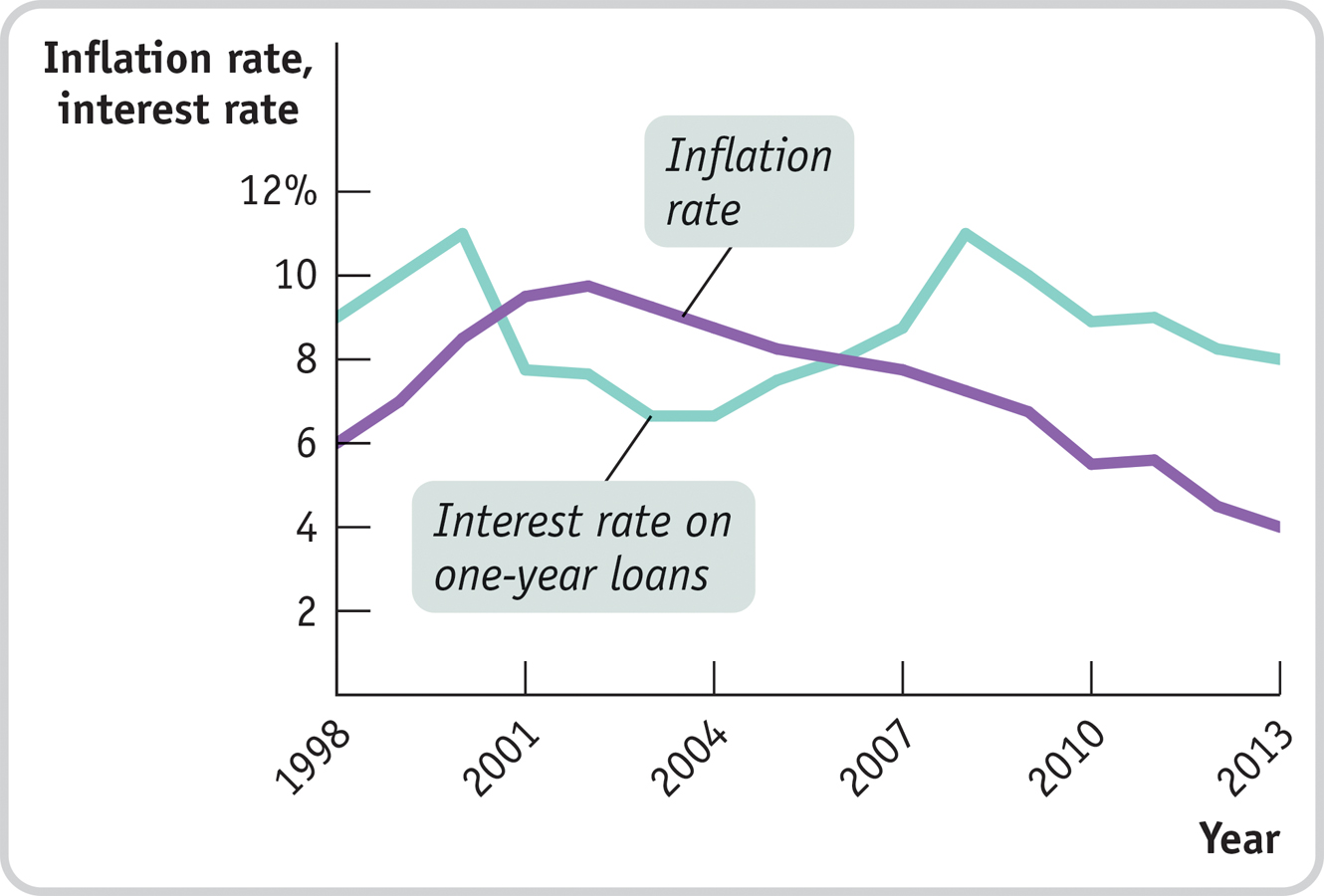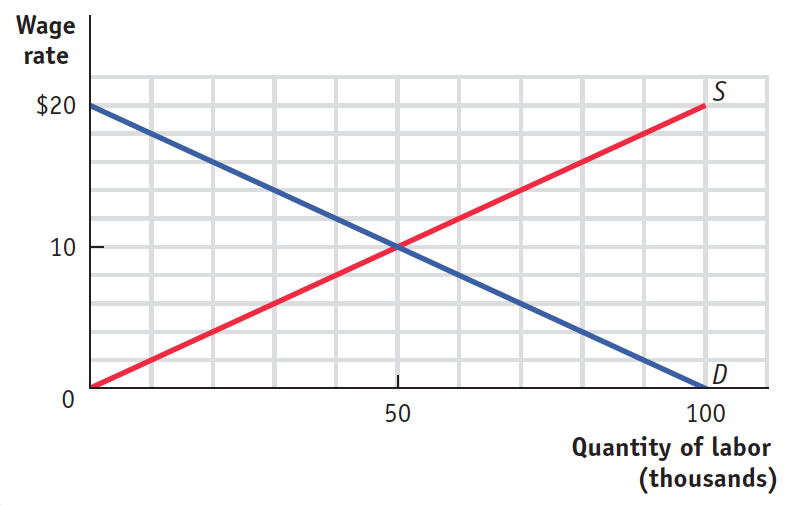PROBLEMS
Question 8.12
Each month, usually on the first Friday of the month, the Bureau of Labor Statistics releases the Employment Situation Summary for the previous month. Go to www.bls.gov and find the latest report. On the Bureau of Labor Statistics home page, at the top of the page, select the “Subjects” tab, find “Unemployment,” and select “National Unemployment Rate.” You will find the Employment Situation Summary under “CPS News Releases” on the left-
hand side of the page. How does the current unemployment rate compare to the rate one month earlier? How does the current unemployment rate compare to the rate one year earlier? Question 8.13
In general, how do changes in the unemployment rate vary with changes in real GDP? After several quarters of a severe recession, explain why we might observe a decrease in the official unemployment rate. Explain why we could see an increase in the official unemployment rate after several quarters of a strong expansion.
Question 8.14
In each of the following situations, what type of unemployment is Melanie facing?
After completing a complex programming project, Melanie is laid off. Her prospects for a new job requiring similar skills are good, and she has signed up with a programmer placement service. She has passed up offers for low-
paying jobs. When Melanie and her co-
workers refused to accept pay cuts, her employer outsourced their programming tasks to workers in another country. This phenomenon is occurring throughout the programming industry. Due to the current slump, Melanie has been laid off from her programming job. Her employer promises to rehire her when business picks up.
Question 8.15
Part of the information released in the Employment Situation Summary concerns how long individuals have been unemployed. Go to www.bls.gov to find the latest report. Use the same technique as in Problem 1 to find the Employment Situation Summary. Near the end of the Employment Situation, click on Table A-
12, titled “Unemployed persons by duration of unemployment.” Use the seasonally adjusted numbers to answer the following questions. How many workers were unemployed less than 5 weeks? What percentage of all unemployed workers do these workers represent? How do these numbers compare to the previous month’s data?
How many workers were unemployed for 27 or more weeks? What percentage of all unemployed workers do these workers represent? How do these numbers compare to the previous month’s data?
How long has the average worker been unemployed (average duration, in weeks)? How does this compare to the average for the previous month’s data?
Comparing the latest month for which there are data with the previous month, has the problem of long-
term unemployment improved or deteriorated?
Question 8.16
A country’s labor force is the sum of the number of employed and unemployed workers. The accompanying table provides data on the size of the labor force and the number of unemployed workers for different regions of the United States.
Labor force (thousands)
Unemployed (thousands)
Region
April 2013
April 2014
April 2013
April 2014
Northeast
28,407.2
28,288.9
2,174.4
1,781.3
South
56,787.8
57,016.4
4,089.9
3,363.8
Midwest
34,320.0
34,467.0
2,473.7
2,109.0
West
36,122.2
36,307.3
2,940.8
2,535.7
Source: Bureau of Labor Statistics.
Calculate the number of workers employed in each of the regions in April 2013 and April 2014. Use your answers to calculate the change in the total number of workers employed between April 2013 and April 2014.
For each region, calculate the growth in the labor force from April 2013 to April 2014.
Compute unemployment rates in the different regions of the country in April 2013 and April 2014.
What can you infer about the fall in unemployment rates over this period? Was it caused by a net gain in the number of jobs or by a large fall in the number of people seeking jobs?
Question 8.17
In which of the following cases is it more likely for efficiency wages to exist? Why?
Jane and her boss work as a team selling ice cream.
Jane sells ice cream without any direct supervision by her boss.
Jane speaks Korean and sells ice cream in a neighborhood in which Korean is the primary language. It is difficult to find another worker who speaks Korean.
Question 8.18
How will the following changes affect the natural rate of unemployment?
The government reduces the time during which an unemployed worker can receive unemployment benefits.
More teenagers focus on their studies and do not look for jobs until after college.
Greater access to the internet leads both potential employers and potential employees to use the internet to list and find jobs.
Union membership declines.
Question 8.19
With its tradition of a job for life for most citizens, Japan once had a much lower unemployment rate than that of the United States; from 1960 to 1995, the unemployment rate in Japan exceeded 3% only once. However, since the crash of its stock market in 1989 and slow economic growth in the 1990s, the job-
for- life system has broken down and unemployment rose to more than 5% in 2003. Explain the likely effect of the breakdown of the job-
for- life system in Japan on the Japanese natural rate of unemployment. As the accompanying diagram shows, the rate of growth of real GDP picked up in Japan after 2001 and before the global economic crisis of 2007–
2009. Explain the likely effect of this increase in real GDP growth on the unemployment rate. Was the likely cause of the change in the unemployment rate during this period a change in the natural rate of unemployment or a change in the cyclical unemployment rate?
 Source: OECD.
Source: OECD.Question 8.20
In the following examples, is inflation creating winners and losers at no net cost to the economy or is inflation imposing a net cost on the economy? If a net cost is being imposed, which type of cost is involved?
When inflation is expected to be high, workers get paid more frequently and make more trips to the bank.
Lanwei is reimbursed by her company for her work-
related travel expenses. Sometimes, however, the company takes a long time to reimburse her. So when inflation is high, she is less willing to travel for her job. Hector Homeowner has a mortgage with a fixed nominal 6% interest rate that he took out five years ago. Over the years, the inflation rate has crept up unexpectedly to its present level of 7%.
In response to unexpectedly high inflation, the manager of Cozy Cottages of Cape Cod must reprint and resend expensive color brochures correcting the price of rentals this season.
Question 8.21
The accompanying diagram shows the interest rate on one-
year loans and inflation during 1998– 2013 in the economy of Albernia. When would one- year loans have been especially attractive and why? 
Question 8.22
The accompanying table provides the inflation rate in the year 2000 and the average inflation rate over the period 2001–
2013 for seven different countries. Country
Inflation rate in 2000
Average inflation rate in 2001–
2013 Brazil
7.06%
6.72%
China
0.4
2.34
France
1.83
1.86
Indonesia
3.77
7.56
Japan
−0.78
−0.23
Turkey
55.03
18.79
United States
3.37
2.43
Source: IMF.
Given the expected relationship between average inflation and menu costs, rank the countries in descending order of menu costs using average inflation over the period 2001–
2013. Rank the countries in order of inflation rates that most favored borrowers with ten-
year loans that were taken out in 2000. Assume that the loans were agreed upon with the expectation that the inflation rate for 2001 to 2013 would be the same as the inflation rate in 2000. Did borrowers who took out ten-
year loans in Japan gain or lose overall versus lenders? Explain.
Question 8.23
The accompanying diagram shows the inflation rate in the United Kingdom from 1980 to 2013.
 Source: IMF.
Source: IMF.Between 1980 and 1985, policy makers in the United Kingdom worked to lower the inflation rate. What would you predict happened to unemployment between 1980 and 1985?
Policy makers in the United Kingdom react forcefully when the inflation rate rises above a target rate of 2%. Why would it be harmful if inflation rose from 2.6% (the level in 2013) to, say, a level of 5%?
WORK IT OUT
For interactive, step-
Question 8.24
13. There is only one labor market in Profunctia. All workers have the same skills, and all firms hire workers with these skills. Use the accompanying diagram, which shows the supply of and demand for labor, to answer the following questions. Illustrate each answer with a diagram.

What is the equilibrium wage rate in Profunctia? At this wage rate, what are the level of employment, the size of the labor force, and the unemployment rate?
If the government of Profunctia sets a minimum wage equal to $12, what will be the level of employment, the size of the labor force, and the unemployment rate?
If unions bargain with the firms in Profunctia and set a wage rate equal to $14, what will be the level of employment, the size of the labor force, and the unemployment rate?
If the concern for retaining workers and encouraging high-
quality work leads firms to set a wage rate equal to $16, what will be the level of employment, the size of the labor force, and the unemployment rate?